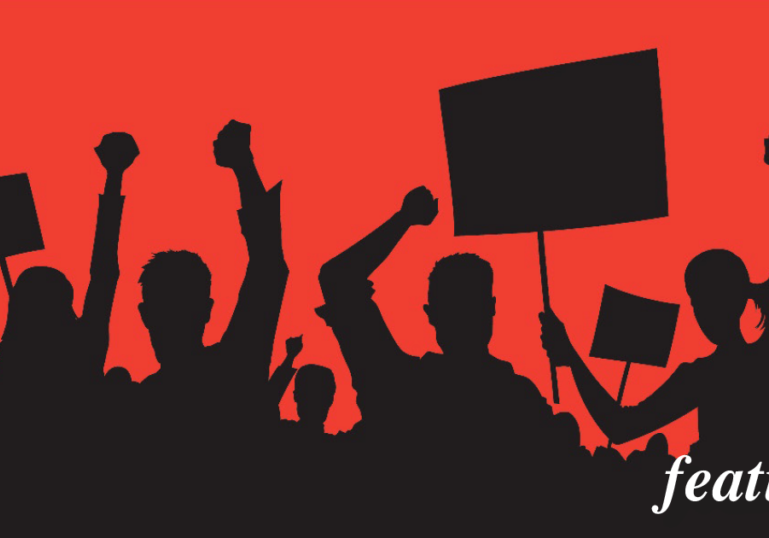This is the story of Ms. H. R. Job – Harriet Rose Job (HR JOB) to her co-workers – who represent all that comprises the function of Human Resources Management in most corporations.
In my last book, The Death of HR: Who Killed Ms. H (Harriet) R. (Rose) Job? published in 2018 before the Covid Pandemic hit the world, Ms. Harriet Rose Job (H.R. JOB) was targeted by many within her organization and done away with. Writing as “Detective” Miller in that book (and also giving presentations as the Detective (see pics), the clues and suspect interviews showed that Ms. H.R. Job – was considered (among other things) as having the work traits that showed her to be – Irrelevant, Indifferent, Indecisive, Incompetent and Inflexible – with no new skills – as he called them – the five fatal “I’s.” There were many suspects back in 2018 who looked good for doing away with Ms. H.R. Job, including Mr. Hugh Resources, Sue “Sis” Stems, Ms. Cher Holder, Juan Management (Senior Management), Ed Konomy, Rob Otics, Mel Lenial, Bebe Boomer, and others. Detective Miller interviewed many of them and determined that most thought Ms. H.R. Job was an obstacle to the company’s success. She was unwilling to change, was not a team player, was stuck in her time, did not try to embrace new technology and methods such as analytics and metrics, and did not seek new ways to become more efficient and more effective.
Ms. H.R. Job Today.
But now, in 2024 and into the future, due to COVID and its impact on the Global Workforce, Ms. H.R. Job is at the center of many issues and initiatives vital to an organization’s survival. HR jobs are now considered critical by all and must be heard and preserved. She must never again die; she must be immortal!
How did this happen? Who and What helped Ms. Harriet Rose Job be resurrected? And become Immortal!?
Enter Ms. Connie Vid (Covid) (See Fig. NN), who created immense challenges for corporations around the globe. Figure NN.
Figure NN.
Many of these challenges were voiced as follows:
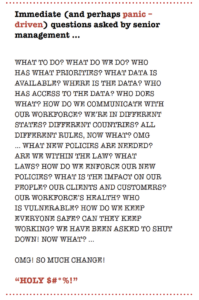
Corporations worldwide realized that they had to act quickly to minimize the impact of the Pandemic on their workforce and, of course, on the very survival of their organizations.
Ms. H.R. JOB – changed her Mindset and realized that she was the keeper of a trove of data and information to help her organization Survive.
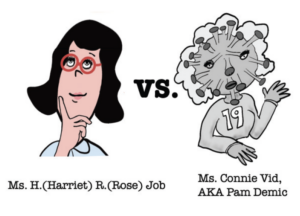 Here is a list of the 9 Mindsets that Harriet Rose Job embraced.
Here is a list of the 9 Mindsets that Harriet Rose Job embraced.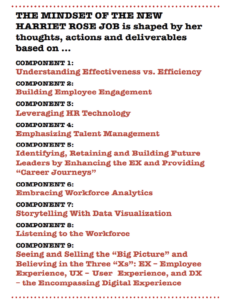
To support her ever-expanding Mindset and the new responsibilities and initiatives that were expected of her (for her company to thrive in the post-COVID world—the “new normal,” so to speak), Ms. H.R. Job set about collaborating with many in her organization to meet the challenges COVID created.
Here are the “people” (functions) who made up the 6 Working Groups. Together with Ms. Harriet Rose Job, they created outcomes that helped her organization survive COVID-19 and positioned it for success and value-adding initiatives post-COVID.
 “ Mission / Challenge, Purpose And Goal:
“ Mission / Challenge, Purpose And Goal:
Their Challenge: Identify, then build, or buy corporate software systems or applications and smartphone apps to leverage HR databases and technologies already in place. These tools can generate metrics and display them on graphically pleasing dashboards to tell a strong “story” that leads to actionable insights. These valuable business insights will, in turn, justify and support HR technology and workforce program expenditures to senior leadership.
Partnerships:
- HR will collaborate with Mr. Chet G. PeTee and Arturo Intelligenti, using the latest advances in AI, including algorithms and data visualization, to build those stories further to show outcomes and workforce impacts in a manner that senior leadership can easily understand.
- Working Group A—People Analytics must work closely with Working Group E—HR Technology to effectively use the underlying data from the company’s already existing HR technology.
This Working Group must also consider all aspects of the EX and gain direction from the voice of the four generations. A significant portion of this Working Group’s time will be in collaboration with the five other Working Groups.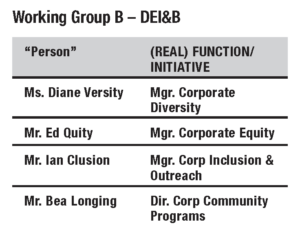
Their Challenge: Increase employee retention, reduce turnover, and attract new employees by building programs that listen to the workforce and their opinions about the company’s current and planned diversity, equity, inclusion, and belonging (DEI&B) initiatives.
Working Group B will promote DEI&B by:
- Developing communications and training outreach to all employees.
- Collaborating with IT to build/buy software and smartphone apps to gain employee input.
- Identifying and creating programs to overcome perceived and actual social and racial injustices.
The Working Group will develop metrics to identify needed actions, track improvements over time, and hold managers accountable for their actions.
Working Group B outcomes will be incorporated into the company’s EX, UX, and DX environments. Their planned initiatives will document that the company seeks to ensure that every employee feels they belong, are heard, and are respected, no matter their background, culture, ethnicity, or race.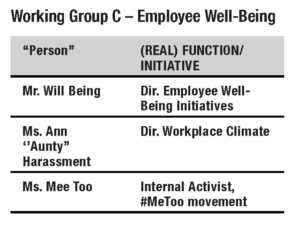 Their Challenge: Similar to Working Group B—DEI&B, the employees’ voices were a clarion call for help in their reaction to the Pandemic. Every employee felt disquiet and uncertainty about their health, the health of their loved ones, their jobs, and their futures.
Their Challenge: Similar to Working Group B—DEI&B, the employees’ voices were a clarion call for help in their reaction to the Pandemic. Every employee felt disquiet and uncertainty about their health, the health of their loved ones, their jobs, and their futures.
Purpose: Working Group C is focused on providing activities and initiatives to support the workforce in their understanding of empathic leadership and to create a supportive work environment that addresses physical, mental, emotional, and social well-being while providing resources to give each employee the information and emotional support needed to navigate their personal and work/life feelings and fears Their Purpose: To attract, develop, engage, and retain top talent using a strategic approach to managing human capital and ensuring that the right people are in the right roles to drive organizational success.
Working Group D also focuses on providing Leadership Development And Upskilling initiatives. These programs offer opportunities for professional growth, career development, and the acquisition of new competencies, and ultimately, they support the identification of future leadership. 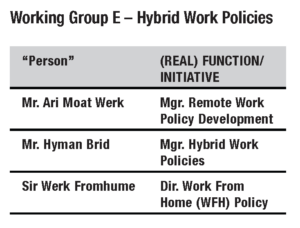
Their Purpose: To establish guidelines and practices that accommodate a flexible work environment where employees can work remotely and in the office. These policies aim to balance the benefits of remote work, such as increased flexibility and work/life balance, with the advantages of in-person collaboration and connection.
At COVID’s beginning, most companies had to quickly transition to fully remote work.
As COVID abates, a hybrid work schedule is a key and remaining component of many companies’ New Normal. Many organizations have attempted to reinstate a full-time Return-to-Office (RTO) protocol (in-office five days a week) but have encountered overwhelming resistance and pushback to these mandates. Depending on the job market, overall economy, work location, and employee work/life situation, employees will either choose to leave or remain.  Their Challenge: To closely collaborate with Ms. H.R. Job to build and implement the technology apps, tools, and related software vital throughout the Pandemic.
Their Challenge: To closely collaborate with Ms. H.R. Job to build and implement the technology apps, tools, and related software vital throughout the Pandemic.
This collaboration enforced the need for her to keep new Mindset components 3 – Leveraging HR Technology and 6 – Embracing Workforce Analytics top of their mind. It resulted in many reasons why HR jobs became needed and “immortal.”
What The Working Groups Delivered By The Pandemic Timeframe
When COVID-19 was declared a Pandemic In March 2020, most companies shut down, sending workers home and locking down, except for first responders and workers deemed “critical ” by government agencies and industry oversight groups.
The Immediate Need: Technology to keep employees informed, reduce their anxiety, and determine what needs to be done for the workforce to produce outcomes that enable the organization to “survive” and stay in business. Policy and program changes came soon after that but still within the first year of the Pandemic.
Smartphone Apps And Corporate Software
- Health monitoring and contact tracing apps were implemented to track potential COVID exposures, monitor symptoms, and facilitate efficient contact tracing protocols to ensure employee safety and minimize the spread of the virus.
- Remote collaboration tools such as Microsoft Teams, Zoom, Slack, or Google Workspace to enable seamless communication and collaboration.
- Virtual meeting platforms like Zoom, Microsoft Teams, or Cisco Webex could be used to conduct meetings, conferences, and client presentations remotely.
- Project management software, such as Asana, Trello, or Jira, could ensure teams can collaborate effectively.
- Facility access and remote access tools built corporate-specific and branded smartphone apps to access vaccination/test results status to govern building entry; implemented virtual private network (VPN) or remote desktop applications like Citrix or TeamViewer.
- Employee wellness apps or platforms were Wellness apps provide resources, guidance, and activities to support physical and mental health, such as meditation apps, fitness apps, so-called “happiness” apps (emojis showing daily feelings), online counseling services, or leader-to-employee check-ins.
- Virtual onboarding solutions and platforms were used to ensure a smooth transition for new hires as companies continued to hire remotely, including virtual training sessions, online document signing, and digital HR platforms.
- Employee engagement platforms, such as adopted software that facilitated virtual team-building activities, recognition programs, and communication channels for employees to connect and share experiences to maintain employee morale and engagement while working remotely.
- Cloud-based file sharing and storage like Dropbox, Google Drive, or Microsoft OneDrive to enable seamless access, sharing, and collaboration of documents and files from any location were included.
- E-learning and training platforms, or learning management systems (LMS), were implemented, offering virtual courses, webinars, and training modules to upskill and reskill the workforce remotely.
After the Initial Impact and Within the First Two Years (Fall 2020 – Through March 2022)
After the immediate needs were addressed, companies began to appraise their first responses and build policies and procedures focused mainly on maintaining the health and well-being of their workforce and ensuring WFH policies were in place and working. Vaccinations received FDA approval for wide distribution in February 2021. The focus shifted to corporate policies regarding testing and vaccination status, and local, state, and federal governments issued work and access guidelines, including overseas travel and immigration entry. Individual corporate mandates for the employee populations followed (and so did many lawsuits challenging these mandates and employment terminations of those not vaccinated).
- Hybrid work models were adopted to provide flexibility while maintaining productivity. This involved implementing policies, technologies, and infrastructure to support a seamless blend of remote and on-site work.
- Vaccination initiatives promoted such as vaccination campaigns, organized vaccination drives, partnering with healthcare providers, and offered incentives to employees for vaccination.
- Health authorities adopted enhanced health and safety protocols, including updated protocols, including mask policies, social distancing measures, regular sanitization of workspaces, and proper hygiene practices.
- Mental health support included employee mental well-being support, providing access to mental health resources, counseling services, and workshops or webinars on stress management and resilience.
- Continued investment in technology included upgrading network capabilities, expanding cloud-based solutions, and implementing advanced cybersecurity measures to ensure data privacy and security.
- Flexible work arrangements were Implemented or revised flexible work arrangements such as adjusted schedules, compressed workweeks, or reduced hours in a solid effort to help employees balance work and personal responsibilities and as a critical tenant to attract new employees.
- Implement enhanced employee communication with robust communication strategies involving regular leadership updates, town hall meetings, and interactive platforms to ensure transparency, address concerns, and inform employees about organizational changes.
- Focus on workforce analytics initiatives were driven by or originated from the results of Workforce Analytics, including straightforward (turnover and length of service calculations) to more complicated (flight risk, sentiment analysis) and other algorithms involving leadership potential (such as the 9-box model).
- Focus on employee well-being placed greater emphasis on holistic well-being beyond physical health, including resources and programs related to work/life balance, stress management, mindfulness, and resilience training to support employees in maintaining their overall well-being.
- Crisis response and contingency planning enhanced crisis response and contingency plans were based on lessons learned early in the Pandemic. This included developing strategies to adapt to changing situations quickly, mitigating risks, and ensuring business continuity in the face of future disruptions.
- Engaged in Social responsibility initiatives to support communities impacted by the Pandemic, including donating funds, resources, or volunteer hours to organizations and initiatives focused on healthcare, education, food security, and other areas affected by the crisis. Depending on local events and activists, companies also put specific language into place to support DEI&B, Workplace Harassment (#MeToo), and ES&G initiatives.
Three Years on (March 2022 – August 2023) but Remaining as Part of the New Normal – into 2024 and to this Very Day!
Many initiatives stemming from the corporate response to COVID, both immediately and over the first two years, remain in place, mainly because in major cities and among a predominate number of industries, Hybrid work or fully remote work was desired by most members of the four generations of the workforce.
Additionally, remote job postings on job boards such as LinkedIn, Indeed, and Zip Recruiter indicate that the desirability of a hybrid or fully remote work location has remained the same as we have recovered from COVID.
These Early Pandemic Responses, Activities, and Initiatives have become part of the “New Normal,” and companies must include most of them to continue to attract leadership-quality talent and a workforce that believes in the corporations’ ongoing strategies:
- Hybrid work models,
- Workplace flexibility,
- Continued focus on health and safety,
- Employee well-being support, and
- Technology investments.
Additionally, some activities, programs, and initiatives in place long before COVID-19 have gained greater importance, visibility, and traction due to the Pandemic. Most remain part of the workforce culture and comprise the “New Normal.”
- Talent retention and recruitment: A continued focus on talent retention and recruitment strategies may involve implementing employee engagement initiatives, offering competitive compensation and benefits packages, and adapting recruitment processes to attract and retain top talent.
- Use of alternative labor sources such as adapting staffing models to increase the use of “gig” workers and other outsourced sources of labor, as well as robotics to replace jobs where appropriate.
- Resilience and contingency planning included effectively responding to future disruptions, applying lessons learned from the Pandemic, and ensuring their readiness to adapt and mitigate risks in an unpredictable environment.
- Embracing digital transformation: Building an encompassing “DX” that focuses on workforce communications and alignment with strategic plans; complete integration with artificial intelligence, workforce analysis, and cloud computing in all aspects of HR (recruiting, career development, upskilling, leadership development, career journeys and pathing, etc.), using developed or purchased software to fully integrate these capabilities within a company’s intranet, employee portal, and branded smartphone apps were adopted.
- Sustainability initiatives: Increasing focus on sustainability and environmental responsibility, adopting eco-friendly practices, implementing sustainable supply chains, and setting targets to reduce their carbon footprint and contribute to a more sustainable future became commonplace.
- Stakeholder engagement: Actively engaging with stakeholders, including employees, customers, investors, and communities, seeking feedback, addressing concerns, and fostering transparent communication to build trust and strengthen relationships were implemented.
A View to the Future
Ms. Harriet Rose Job’s journey towards Immortality, or at least being critically needed, required her to gain a strong recognition of the multiple HR/workforce trends that, driven initially by the onset of the Pandemic, have remained the foundation for ALL HR initiatives. Those HR initiatives must be supported by, and depend on, the strong collaboration with most (if not all) of the departments and functions within the realm of Human Resources Management and the overall operating entities within the organization. The result is deliverables shaped by knowing the critical needs now, today, and in the foreseeable future.
Here is a diagram of the components of HR that must be recognized and acted upon by any knowledgeable HR professional (sooner or later):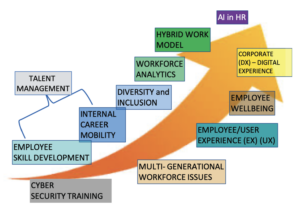 Typically, the end of every year brings hundreds of articles, eBooks, and white papers predicting the upcoming year’s top trends and issues facing HR, HR technology, and its use in supporting the workforce.
Typically, the end of every year brings hundreds of articles, eBooks, and white papers predicting the upcoming year’s top trends and issues facing HR, HR technology, and its use in supporting the workforce.
I saw many articles in 2022 and 2023 driven by the common theme of how the global workforce has recovered, been altered, and reset. Issues ranging from work-from-home or hybrid work to social issues such as ESG, DEI&B, and workplace harassment were addressed relative to HR’s role, position, and vulnerabilities as the “New Normal” takes hold.
Most top trends focused on the behaviors, mentality, and expectations of a workforce comprised of four generations of workers.
Additionally, many articles and white papers addressed the emergence of generative AI — first given wide publicity in November 2022 — with speculation about its uses and impact on almost everything.
Since I focus on the alignment of HR and HR technology, my research and inbox were full of predictions related to the effect of the recovery from COVID-19 on the functions and technology within the realm of Human Resources.
These future trends, individually or in various groupings, were formative to Ms. H.R. Job’s new Mindset and led to HR initiatives or specific programs that contributed to building the triangle shown below.
Here, you see the interrelationship between component trends and how HR Tech and Analytics support everything. This results in the role and function of HR (embodied in Ms. H.R. Job) becoming a needed and critical Strategic Business Partner (as opposed to just having “Strategic Expertise”) helping the organization survive COVID and the transition to the “New Normal.”
These components will be in play for many years to come.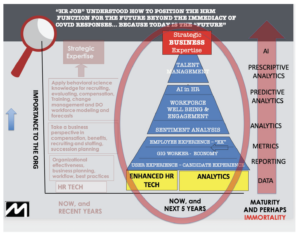 Here’s my take on HR Priorities (or Trends), which I am confident will still exist.
Here’s my take on HR Priorities (or Trends), which I am confident will still exist.
Two stand out, having already impacted HR and will continue to do so. These, in particular, must be understood and embraced by anyone in an HR job or function. They are included below in my list of the Top 2024 Trends and Beyond, many of which have already been embraced by Harriet Rose Job’s new Mindset. The most impactful for HR is the now (as I write this) extraordinary (and expected and anticipated and proven) day-to-day use of Generative AI in almost any industry worldwide.
- Hybrid work and working from home will remain major attraction and retention factors.
- Company culture will emphasize a more “holistic” view of workers, and leaders will be given explicit mandates to be more “human at work.”
- Employee well-being and mental health support will be prevalent and formally visible in corporate operations.
- AI will continue to alter the workflow of most processes in most industries. Within HR Management, the impact will be felt first in Talent Acquisition: Onboarding and Recruiting.
- HR technology provided by vendor solutions will continue to improve and support employee health and well-being.
- HR will continue to elevate itself, with more leaders achieving C-level positions.
- The Digital Experience (DX) will gain traction and include more than typical HR functions.
- Compelling, personalized, and differentiated employee experiences (EX) remain critical.
- HR tech investments will continue to grow, with more vendor solutions using embedded AI within their core deliverables.
- People Analytics will be pervasive within all functions and explicitly drive organizational strategies.
Here are a few more details underlying the importance of these trends and the potential outcome and deliverables by HR professionals:
- The Impact of Generative AI on specific HR functions, concerns about AI taking jobs away, employers dealing with the risks of AI use by employees, bias, regulatory matters, current and future lawsuits, copyright issues, usage in all forms of research, academic integrity, and many more unforeseen impacts will continue to either accelerate the adaption or create a cause for concern and might generate a pause or slowing down on how AI is a further adopted by the global workforce, the corporations, and the community at large.
- The Impact of The Global Economy, Current Wars, and Global Political Shifts will also Impact the Regulatory Drive For AI and Workforce Accommodations. Stay tuned for those in the year or two ahead.
To sum up, Harriet Rose Job’s future is tied to the trends discussed and her mindful embrace of the holistic view of HR.
She achieved “Immortality” and must strive to remain “Immortal” by continuing to believe in her new Mindset by keeping in mind these thoughts:
- Continue to have solid and focused collaborations with HR colleagues and any senior leadership in position to help Harriet Rose Job carry out programs with her colleagues on current and predictable issues based on “actionable insights.”
- HR tech spending must increase.
- Seek new smartphone-based apps and dashboards.
- Keep employee well-being a high priority.
- Factor in “coolness” into all EX and UX applications, starting with onboarding.
- Pay high attention to maintaining an appropriate work/personal life balance for all employees.
- Focus less on administration and use HR technology to improve workflow efficiency and effectiveness.
- Embrace the company’s commitment to more community-based activities and consider offering “paid time off” to participating employees.
- Maintain a reasonable focus on diversity, equity, inclusion, and belonging across all company policies and procedures.
- Pay close attention to data access, as security remains critical internally, as well as what third-party HR tech providers
- Encourage more smartphone app development, including social media integrations within the corporate communications framework.
- Give due attention and caution about cybersecurity threats from external (vendors) and within the internal workforce.
So, What Will Your Future Be?
Will you follow in Harriet Rose Job’s footsteps and make your mindset adjustments? What “Experience” do you want for yourself as an HR Leader? Will you knowingly place yourself on the proverbial “Path to Immortality”?
Thank you for reading. If you are interested in finding out more, consider viewing details about my book Immortal HR: The Death And Resurrection Of Ms. H. (Harriet) R. (Rose) Job, which describes how COVID and Workforce Issues Made HR Jobs Critical and indispensable! (If Not Immortal).

